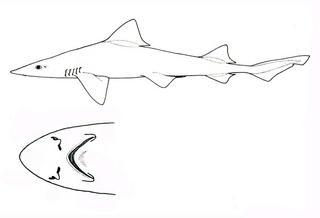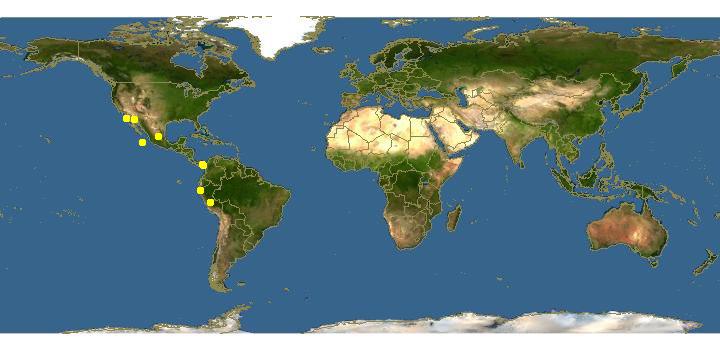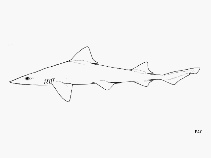
www.fao.org Copyright Michel Lamboeuf · 0
Mustelus dorsalis |

Click on map for details about points.
|
| Links |
We parsed the following live from the Web into this page. Such content is managed by its original site and not cached on Discover Life. Please send feedback and corrections directly to the source. See original regarding copyrights and terms of use.
- FishBase
|
|
español |
|
|
Overview |
Main identification features
- lip folds: upper greater than lowerspiracles largenostrils long
- 1st dorsal fin : triangular, nearer pelvic than pectoral
- teeth pointed
- skin denticles: 1 point
- c: lower lobe not expanded
Elongate, slender body; eyes horizontal ovals, with ventral nictitating membranes; snout pointed; mouth angular, long; teeth high, triangular; nostril length 84-95% of distance between them; spiracle length 1.1-1.2% of total length; width between eyes = 5.1-6.2% of total length; 5 gill slits, last 2 over pectoral fin base; 2 large dorsal fins, second slightly smaller than first; first dorsal broadly triangular, center nearer pelvic than pectoral; anal fin smaller than and with origin under middle of second dorsal; tail strongly asymmetrical, lower lobe not expanded, not with concave rear edge; skin denticles with single point.
Grey to grey-brown, paler below.
Size: 64 cm.
Habitat: continental shelf, demersal.
Depth: 20-200 m.
Central Mexico to Peru, and Malpelo.
Attributes
Abundance: Common.
Cites: Not listed.
Climate Zone: Northern Tropical (Mexican Province to Nicaragua + Revillagigedos); Equatorial (Costa Rica to Ecuador + Galapagos, Clipperton, Cocos, Malpelo); South Temperate (Peruvian Province ); Northern Subtropical (Cortez Province + Sinaloan Gap).
Depth Range Max: 200 m.
Depth Range Min: 20 m.
Diet: bony fishes; mobile benthic worms; mobile benthic gastropods/bivalves; mobile benthic crustacea (shrimps/crabs).
Eastern Pacific Range: Northern limit=21; Southern limit=-6; Western limit=-106; Eastern limit=-78; Latitudinal range=27; Longitudinal range=28.
Egg Type: Live birth; No pelagic larva.
Feeding Group: Carnivore.
FishBase Habitat: Demersal.
Global Endemism: Tropical Eastern Pacific (TEP) endemic; East Pacific endemic; All species.
Habitat: Mud; Sand & gravel; Soft bottom (mud, sand,gravel, beach, estuary & mangrove); Soft bottom only.
Inshore Offshore: Inshore; Inshore Only.
IUCN Red List: Data deficient; Listed.
Length Max: 64 cm.
Regional Endemism: Island (s); Continent; Continent + Island (s); TEP endemic; All species.
Residency: Resident.
Salinity: Marine; Marine Only.
Water Column Position: Bottom; Bottom only;
|
|
|
Names | |
|
|
|
Links to other sites | |
|
|
|
References |
- Béarez, P., 1996., Lista de los Peces Marinos del Ecuador Continental., Revista de Biologia Tropical, 44:731-741.
- Compagno, L.J.V., 1999., Checklist of living elasmobranchs. In Hamlett W.C. (ed.) Sharks, skates, and rays: the biology of elasmobranch fishes., The John Hopkins University Press:471-498.
- Compagno, L.J.V., 1984., Sharks of the World. An annotated and illustrated catalogue of shark species known to date. Part 2. Carcharhiniformes. FAO Species Catalogue., FAO Fish. Synop. No 125, 4(2):251-655.
- Fischer , W. , Krup , F. , Schneider , W. , Sommer , C. , Carpenter , K. E. and Niem, V. H., 1995., Guia FAO para la Identificacion de Especies de para los fines de la Pesca. Pacifico Centro-Oriental. Volumen II. Vertebrados - Parte 1., FAO2:647-1200.
- Gill, T.N., 1864., Second contribution to the selachology of California., Proc. Acad. Nat. Sci. Phila., 16:147-151.
- Hildebrand, S.F., 1946., A descriptive catalog of the shore fishes of Peru., Bull. U.S. Nat. Mus., 189:1-530.
- Jimenez-Prado, P., Béarez, P., 2004., Peces marinos del Ecuador continental / Marine fishes of continental Ecuador., SIMBIOE/NAZCA/IFEA tomo 1 y 2.
- Lopez , M. I. and Bussing, W. A., 1982., Lista provisional de los peces marinos de la Costa Rica., Revista de Biologia Tropical, 30(1):5-26.
- Love, M.S., Mecklenburg, C.W., Mecklenburg, T.A., Thorsteinson, L.K., 2005., es of the West Coast and Alaska: a checklist of North Pacific and Artic Ocena species from Baja California to the Alaska-Yukon border., U.S. Department of the Interior, U.S. Geological Survey, Biological Resources Division, 288pp.
- Meek , S.E. and Hildebrand, S.F., 1923., The marine fishes of Panama. Part I., Field Mus. Nat. Hist., Zool. Ser. Publ., XV:1-330.
- Osburn , R. C. and Nichols, J. T., 1916., Shore Fishes Collected by the 'Albatross' Expedition in Lower California with Descriptions of New Species., Bull. Amer. Mus. Nat. Hist., 35:139-181.
- Pérez Jiménez, J.C., Sosa Nishizaki, O., Castillo Geniz, J.L., 2005., A new Eastern North Pacific smoothhound shark (Genus Mustelus, Family Triakidae) from the Gulf of California., Copeia, 2005:834-845.
- Rubio, E.A., 1986., Notas sobre la ictiofauna de la Isla de Gorgona, Colombia., Boletin Ecotropica. Univ. Bog. Jorge Tadeo Lozano, 13:86-112.
- Rubio, E.A., 1988., Estudio taxonomico de la ictiofauna acompañante del camaron en areas costeras del Pacifico de Colombia., Memorias del VI Seminario Nacional de las Ciencias del Mar. Comisión Colombiana de Oceanografía. Bogota, Colombia., :169-183.
|
|
|
Acknowledgements | |
I thank Ashley MacDonald and John Pickering, University of Georgia, for technical support in building this page.
|
|
| Supported by | |
|
Following modified from FishBase
|
Top | See original
http://www.fishbase.org/Summary/speciesSummary.php?genusname=Mustelus&speciesname=dorsalis ---> http://192.134.151.83/Summary/speciesSummary.php?genusname=Mustelus&speciesname=dorsalis
http://192.134.151.83/Summary/speciesSummary.php?genusname=Mustelus&speciesname=dorsalis ---> https://fishbase.mnhn.fr/Summary/speciesSummary.php?genusname=Mustelus&speciesname=dorsalis
https://fishbase.mnhn.fr/Summary/speciesSummary.php?genusname=Mustelus&speciesname=dorsalis ---> https://fishbase.mnhn.fr/summary/Mustelus-dorsalis.html
Mustelus dorsalis, Sharptooth smooth-hound : fisheries

You can
sponsor
this page
Common name (e.g. trout)
Genus + Species (e.g. Gadus morhua)
-

-
About this page
-
Languages
-
User feedbacks
-
Citation
-
Uploads
-
Related species
-


 Sharptooth smooth-hound
Add your observation in
Fish Watcher
Upload your
photos
and
videos
Sharptooth smooth-hound
Add your observation in
Fish Watcher
Upload your
photos
and
videos
Pictures
|
Google image
 Mustelus dorsalis
Mustelus dorsalis
Picture by
FAO
Elasmobranchii (sharks and rays) >
Carcharhiniformes
(Ground sharks) >
Triakidae
(Houndsharks) > Triakinae
Etymology:
Mustelus:
Latin for weasel, an ancient name for sharks, possibly referring to the pointed snouts, swift movements and/or rapacious feeding behavior of smaller predatory sharks [strictly not tautonymous with
Squalus mustelus
Linnaeus 1758 since type was designated by the ICZN]. (
See ETYFish
)
;
dorsalis:
Latin for âof the back,â referring to âprojection of the posterior angle of the first dorsal fin to the vertical of the origin of the ventralsâ. (
See ETYFish
)
.
More on author:
Gill
.
Environment: milieu / climate zone / depth range / distribution range
Ecology
Marine; demersal; depth range 20 - 200 m (Ref.
96339
). Tropical; 20°N - 5°S
Eastern Pacific: southern Mexico to Peru.
Length at first maturity / Size / Weight / Age
Maturity: L
m
?
, range 43 - ? cm
Max length : 64.0 cm male/unsexed; (Ref.
9253
)
An inshore bottom-dwelling shark found on the continental shelves. Feeds primarily on shrimps and probably other crustaceans. Viviparous (with a yolk-sac placenta), with 4 young in a litter. Size at birth, 21 to 23 cm.
Viviparous, with a yolk-sac placenta (Ref.
244
).
Compagno, L.J.V.
, 1984. FAO Species Catalogue. Vol. 4. Sharks of the world. An annotated and illustrated catalogue of shark species known to date. Part 2 - Carcharhiniformes. FAO Fish. Synop. 125(4/2):251-655. Rome: FAO. (Ref.
244
)
IUCN Red List Status (Ref.
130435
)
Vulnerable (VU)
(A2d); Date assessed:
24 February 2020
CITES
Not Evaluated
Not Evaluated
Threat to humans
Harmless
Human uses
Fisheries: minor commercial
FAO - Publication:
search
|
FishSource
|
More information
Countries
FAO areas
Ecosystems
Occurrences
Introductions
Stocks
Ecology
Diet
Food items
Food consumption
Ration
Common names
Synonyms
Metabolism
Predators
Ecotoxicology
Reproduction
Maturity
Spawning
Spawning aggregation
Fecundity
Eggs
Egg development
Age/Size
Growth
Length-weight
Length-length
Length-frequencies
Morphometrics
Morphology
Larvae
Larval dynamics
Recruitment
Abundance
BRUVS
References
Aquaculture
Aquaculture profile
Strains
Genetics
Electrophoreses
Heritability
Diseases
Processing
Nutrients
Mass conversion
Collaborators
Pictures
Stamps, Coins Misc.
Sounds
Ciguatera
Speed
Swim. type
Gill area
Otoliths
Brains
Vision
Tools
E-book
|
Field guide
|
Length-frequency wizard
|
Life-history tool
|
Point map
|
Classification Tree
|
Catch-MSY
|
Special reports
Check for Aquarium maintenance
|
Check for Species Fact Sheets
|
Check for Aquaculture Fact Sheets
Download XML
Summary page
|
Point data
|
Common names
|
Photos
Internet sources
AFORO (otoliths) |
Aquatic Commons
|
BHL
|
Cloffa
|
BOLDSystems
|
Websites from users
|
Check FishWatcher
|
CISTI
|
Catalog of Fishes
:
genus
,
species
|
DiscoverLife
|
ECOTOX
| FAO - Publication:
search
|
Faunafri
| Fishipedia |
Fishtrace
| GenBank:
genome
,
nucleotide
| GloBI |
Google Books
|
Google Scholar
|
Google
| IGFA World Record |
MitoFish
|
Otolith Atlas of Taiwan Fishes
|
PubMed
| Reef Life Survey | Socotra Atlas |
Tree of Life
| Wikipedia:
Go
,
Search
| World Records Freshwater Fishing |
Zoobank
|
Zoological Record
Estimates based on models
Preferred temperature (Ref.
123201
): 14.8 - 26, mean 16.6 °C (based on 31 cells).
Phylogenetic diversity index (Ref.
82804
): PD
50
= 0.5000 [Uniqueness, from 0.5 = low to 2.0 = high].
Bayesian length-weight: a=0.00224 (0.00105 - 0.00478), b=3.14 (2.97 - 3.31), in cm total length, based on LWR estimates for this Genus-body shape (Ref.
93245
).
Trophic level (Ref.
69278
): 3.6 ±0.55 se; based on food items.
Resilience (Ref.
120179
): Very Low, minimum population doubling time more than 14 years (Fec=4).
Fishing Vulnerability (Ref.
59153
): Very high vulnerability (79 of 100).
Price category (Ref.
80766
):
Medium
.
Nutrients (Ref.
124155
): Calcium = 36.2 [10.6, 179.4] mg/100g; Iron = 0.511 [0.153, 1.851] mg/100g; Protein = 20.7 [18.4, 23.0] %; Omega3 = 0.0958 [, ] g/100g; Selenium = 72.1 [21.3, 262.4] μg/100g; VitaminA = 18.2 [6.7, 48.0] μg/100g; Zinc = 1.12 [0.50, 2.28] mg/100g (wet weight);
Back to Search
Random Species
Back to Top
Accessed through:
Not available
FishBase mirror site :
localhost
Page last modified by :
mrius-barile
- 20 July 2016
Fatal error
: Uncaught ArgumentCountError: Too few arguments to function checkEcotox(), 1 passed in /var/www/html/summary/speciessummary.php on line 2304 and exactly 3 expected in /var/www/html/includes/speciessummary.lib.php:2579 Stack trace: #0 /var/www/html/summary/speciessummary.php(2304): checkEcotox() #1 {main} thrown in
/var/www/html/includes/speciessummary.lib.php
on line
2579
|
Updated: 2024-05-23 04:22:54 gmt
|